The third day contained little in the way of presentations.
First, I visited the Eco drive event in the basement. In past years, they stuck suppliers and the Chinese down here. This year, with Nissan and Porsche absent and others asking for less space, those got space on the main floor. So what to do in the basement? How about a lavishly landscaped road course on which to sample hybrids and such?
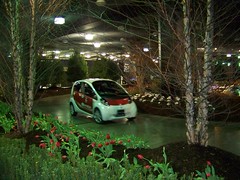 The public will only be able to ride along–it’s been deemed too risky to let them drive. The press gets to drive, but only up to 10 MPH and with a guide in the passenger seat. One talked my ear off–you’d think I’d never driven a car before–but the others were okay. And the cars? Well, up to 10 MPH they feel just like any other car. Just with especially lifeless steering–nothing but electric-assist systems here. To their credit, the brakes all felt natural, not something that could be said for older hybrids. I did sample one more exotic machine, a Chevrolet Equinox powered by a hydrogen fuel cell. Yep, felt just like a regular Equinox, at least at these speeds.
The public will only be able to ride along–it’s been deemed too risky to let them drive. The press gets to drive, but only up to 10 MPH and with a guide in the passenger seat. One talked my ear off–you’d think I’d never driven a car before–but the others were okay. And the cars? Well, up to 10 MPH they feel just like any other car. Just with especially lifeless steering–nothing but electric-assist systems here. To their credit, the brakes all felt natural, not something that could be said for older hybrids. I did sample one more exotic machine, a Chevrolet Equinox powered by a hydrogen fuel cell. Yep, felt just like a regular Equinox, at least at these speeds.
Next I attended the presentation of the “Eyes on Design” awards. These are meaningful, since dozens of designers vote to decide the best designs at the show. Four awards are given, two for concepts and two for production cars. Unlike in past years, nothing distinguished the two winners in each category. Not even first and second place.
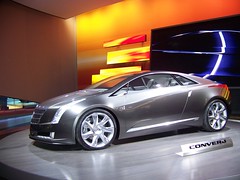 The winners in the concept category were no surprise. The Cadillac Converj, based on the Chevy Volt, easily had the strongest reaction of any concept during the show. And the Audi Sportback was chock full of interesting details
The winners in the concept category were no surprise. The Cadillac Converj, based on the Chevy Volt, easily had the strongest reaction of any concept during the show. And the Audi Sportback was chock full of interesting details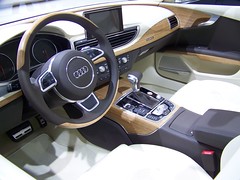 The only other concepts that deserved a shot were Chrysler’s 200C EV (photo in earlier post) and Volvo’s S60 precursor (photo below). Other concepts were either weird (Lincoln’s) or uninteresting (the precursor for Subaru’s next Legacy). There weren’t many concepts this year. Not much money to spend on them, and all that.
The only other concepts that deserved a shot were Chrysler’s 200C EV (photo in earlier post) and Volvo’s S60 precursor (photo below). Other concepts were either weird (Lincoln’s) or uninteresting (the precursor for Subaru’s next Legacy). There weren’t many concepts this year. Not much money to spend on them, and all that.
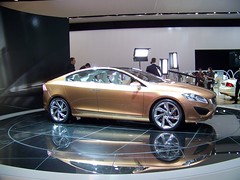 The winners in the production category were a surprise, at least to me. First they announced the Audi R8 5.2. Sure the V10 is new, and I believe the body was lengthened a bit to include it, but the design isn’t new. A lame selection.
The winners in the production category were a surprise, at least to me. First they announced the Audi R8 5.2. Sure the V10 is new, and I believe the body was lengthened a bit to include it, but the design isn’t new. A lame selection.
The other winner: the BMW Z4. Which is good mainly to the extent that it isn’t bad–i.e. Bangled like the first-gen Z4. There’s nothing especially new or exciting about it.
 So if an already familiar Audi and a cleaned-up BMW managed to win, what does this say about the designs Detroit is counting on to save it? I’m not a huge fan of the exteriors of the Buick LaCrosse, Cadillac SRX, Chevrolet Equinox, Ford Taurus, or Lincoln MKT, but some of them do more for me than the BMW. And as far as I’m concerned the Audi shouldn’t have been eligible. Also, the interiors of the Buick and Lincoln are the best yet from their manufacturers. Still, it seems that designers weren’t enthusiastic about Detroit’s 2010s. Not a good sign.
So if an already familiar Audi and a cleaned-up BMW managed to win, what does this say about the designs Detroit is counting on to save it? I’m not a huge fan of the exteriors of the Buick LaCrosse, Cadillac SRX, Chevrolet Equinox, Ford Taurus, or Lincoln MKT, but some of them do more for me than the BMW. And as far as I’m concerned the Audi shouldn’t have been eligible. Also, the interiors of the Buick and Lincoln are the best yet from their manufacturers. Still, it seems that designers weren’t enthusiastic about Detroit’s 2010s. Not a good sign.
Also absent from the winners: both of Fisker’s Karmas. Apparently designers aren’t impressed when one of their own starts his own company from scratch.
Finally, Tesla presented. How did they end up as the only manufacturer presenting on this sparsely attended third day? Clearly someone didn’t do their job. Or is it cheaper to present on the third day?
The focus of CEO Elon Musk’s presentation: Daimler just gave them permission to announce that Tesla will be supplying batteries and chargers for the upcoming Smart EV. Which will enable Tesla to reap greater economies of scale, and advance the day when electric propulsion is cheap enough for the masses.
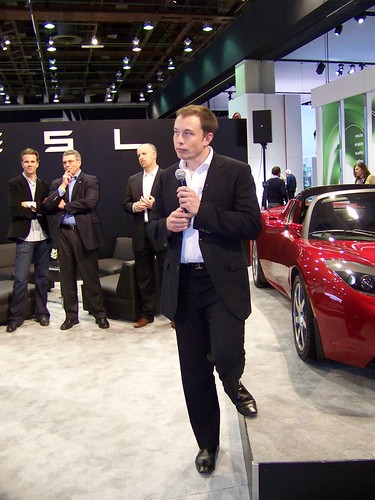 Questions concerned Tesla’s reliance on a large number of small cells, the planned S family sedan, and what Elon Musk has learned from the experience. Economies of scale are much greater with small cells, so it’s cheaper to use them for at least the next few years. The S sedan will cost $49,900 after a tax credit of $7,500, and will be introduced two years after they get a hoped-for Dept. of Energy loan. My pricing analysis: this price makes it about half that of the Fisker, so the two won’t directly compete. The Volt will be a direct competitor. And what has he learned after investing $70 million of his own money? That more automotive experience was needed, and as a result nearly the entire executive team has been replaced. Mr. Musk seemed a bit worn out, and less confident than the bunch across the aisle at Fisker. Must say I understand.
Questions concerned Tesla’s reliance on a large number of small cells, the planned S family sedan, and what Elon Musk has learned from the experience. Economies of scale are much greater with small cells, so it’s cheaper to use them for at least the next few years. The S sedan will cost $49,900 after a tax credit of $7,500, and will be introduced two years after they get a hoped-for Dept. of Energy loan. My pricing analysis: this price makes it about half that of the Fisker, so the two won’t directly compete. The Volt will be a direct competitor. And what has he learned after investing $70 million of his own money? That more automotive experience was needed, and as a result nearly the entire executive team has been replaced. Mr. Musk seemed a bit worn out, and less confident than the bunch across the aisle at Fisker. Must say I understand.
Tesla also showed video of an upcoming higher-performance variant of their Elise-based roadster. Acceleration time to 60 will improve from 3.9 to 3.7. No one in the press corps seemed to care about that bit of news.